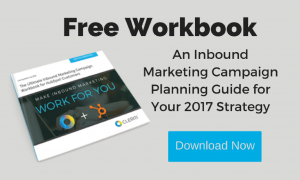 By: Sarah Tsai, Cleriti
By: Sarah Tsai, Cleriti
As Content Production Month partner, Cleriti hosted a workshop called “On Point Content Creation.” My co-worker Senior Content Strategist Jennifer Barnhart and I had a blast working with a room of marketing self-starters in every industry, including healthcare, machinery, architecture, educators, and yoga gurus who were all looking to create content. And one thing we noticed is that even if you’re a one-person show or you have a team to help you, everyone was eager to learn how to incorporate content marketing into their existing marketing strategy. From blog posts to social media to website copy, learning how to develop a strong content marketing schedule and practice that works for your needs will enable you to improve your marketing effectiveness.
In case you weren’t able to attend, here is a recap of some of the materials shared in our “classroom” experience at the workshop.
How a Blog Is Typically Created
or, a Sad Story That Goes on For Months, Sometimes Years
The boss says everyone is doing blogs so we should too. Let’s all chip in and hold a meeting and get The Blog Project up and running. Once everyone is assembled, we ask everyone for topic ideas and maybe start putting a calendar together. But wait, scratch that, everyone is too busy right now to contribute so one person decides to just write the titles and tells the sales team to start writing when they can squeeze in a few minutes. A few weeks later, everyone still means to try to get to it, but so far there’s nothing. A couple months go by and another meeting is proposed to revive The Blog Project, but nobody can make it. A couple months later, still floundering, but there’s no real accountability so The Blog Project remains something that would be nice to do rather than something that is happening.
Does this scenario sound familiar? Instead of this sad tale, let’s write a new story. A story about how content will be created with strategic intent and focus.
Getting Back to Why We Want Content
The purpose of a blog isn’t to fit in with other companies or to make the boss happy because you did what she wanted.
A well-functioning blog is there to help bring in new leads and build real sales.
The content is there for current and potential customers to build trust in your company and your products or services. This works because your content showcases how you are an expert in your industry, a dependable source of information, and a place to find actionable solutions to everyday problems.
When you provide this information without asking for anything in return, people start building trust. Beginning your content creation strategy from this perspective will make the process clearer. Our process starts with a long look at who we are trying to reach and only tackles the actual content in the very last step.
Step 1: The Buyer Persona
A buyer persona is a characterized representation of your ideal customer. This persona cannot encompass everyone because not all customers are going to be the right fit for your company. Instead, zero in on who would be the best fit so you can plan content he or she will find helpful.
How do you capture the essentials of your ideal customer? By defining the following about him or her:
- Personality. Understanding general personality traits will help you set the tone and language of your content.
- Demographics. Include all the basics: age, marital status, income, housing, children.
- Industry and Job Responsibilities. Are you talking to a decision-maker or an influencer? An industry person who wants to hear the lingo, or the office team who may not speak the same language?
- A Day in The Life. What does it look like? Even B2B marketers need to consider the morning and evening hours of their customers.
- Goals and Objectives. Your customer’s goals must become your goals.
- Strategies in Place. What is she doing now that’s working? What is not working, and how can you help?
- Who are the Associates? Who is working closely with your customers and informing their decisions or making their jobs more difficult?
- Change Drivers. Some people are quick to make changes; others are happy to stay put until they are more motivated. What is the case for your customer?
- Common Questions. You want to have answers readily available to show that you understand and you can help.
- Objections to Your Products or Services. When you know what the barriers are, you can get a head start at breaking them down.
Step 2: Campaign Theme & Keywords
Each campaign should be focused on one challenge that your persona faces. Today, when people face problems they usually turn to the Internet for answers. You want to be there before they start looking so pick a problem, solve it, and create content to demonstrate the solution. Each campaign theme should consider the following factors:
- Top Challenges. Start with the most important ones first.
- Seasonal Trends. Plan your summer campaigns well in advance so they’re ready to roll out in time.
- Career Development Opportunities. Can you help your persona do her job better, or gain skills that will fuel growth?
- How to Do Something Better. Can you provide new ways to do something, or different ways to approach a process that saves time and money?
Once you have your theme, think of a relevant keyword that your persona would use in their online search. What would she type into that search bar to solve her problems?
Step 3: Advanced Offer
This offer will become the center of your campaign strategy and will be used to generate leads at the top of your funnel. It should be the ultimate guide that focuses on the problems and solutions you’re using for your campaign theme, and must be viewed as something of high value and relevancy to your persona?
Why so serious? Because this is the offer you are going to gate (or, place behind a landing page with a form) to acquire leads.
Everything you create for the duration of your campaign will lead to this gated content, and it has to be something your persona will trade her contact information to receive.
Some ideas for Advanced Offers include:
- eBook, Whitepaper, Guide
- Webinars and Video Tutorials
- Podcast Series
- Online Course
- Online Assessment or Quiz
Step 4: Content Plan & Blog Schedule
Only now is the time right to consider your content. Once you’ve done all this legwork, it will probably be easy for you to understand why past efforts may have fallen flat. Consider your blog schedule to be the backbone of your campaign. It will be used to hold everyone accountable because it contains all the details and deadlines you need to stay on course.
Each post you create must be relevant to your campaign and lead to your advanced offer landing page. Follow these steps to create an awesome content plan.
- Start with the keywords from Step 2.
- Titles should relate to the topic of the advanced offer.
- Create 13 post titles (one per week for three months)
- Write search meta descriptions to help people find each post and get an abstract view. These descriptions will also guide the rest of the writing.
- Only work two weeks ahead of schedule. You want to be able to tap into trending topics and incorporate the latest research so save the final drafting for last.
The Process in Action
One of our seminar attendees, Michael Loch, arrived with only the knowledge that he wanted to use blogging to boost membership for his health and wellness center at Northern Kentucky University (NKU) while also promoting the idea that the organization is more than just a gym. With these goals in mind, in the space of a little over two hours during our seminar, he left with a plan of action he can put to use right away:
Step 1: Michael defined his buyer persona as a mother, Carla, who is part of a nuclear family living in suburban, middle-class Northern Kentucky.
Step 2: Carla has plenty of pain points and common questions that will become the focus of Michael’s content campaigns. The most important include wanting to know what programs the facility offers, whether they have the equipment, classes, and trainers Carla likes, and what family-oriented programs are available.
Some of Carla’s other roadblocks include membership fees, signup fees, and contracts, and whether these fees fit within the family’s budget, parking, hours and availability, whether crowding is an issue due to the campus location, and how welcoming the facility is toward children.
Step 3: An advanced offer was not originally on Michael’s must-include list. Now he is considering a free trial membership, downloadable fitness guides, health & wellness guides, and video tutorials of trainers providing techniques and tips to offer in exchange for Carla’s contact information.
Step 4: Michael came up with two great blog titles on the spot, both seasonally appropriate for the beginning of the new year as so many people include fitness and health goals in their annual resolutions. His two titles, “Avoid These 5 Mistakes When Pursuing Your Fitness Goals,” and “10 Ways to Stay Focused and Achieve Your Goals,” both provide ways to tie into Carla’s pain points as well as an advanced offer.
If Michael was able to accomplish this much in the span of a couple hours, imagine how awesome the rest of his year will be? You can enjoy the same results with our four-step process, and never waste another minute in a long meeting that goes nowhere. Best of luck navigating the balance between quality and quantity when it comes to producing content!
About Sarah Tsai
Sarah Tsai is a digital marketer who leverages her background in disruptive innovation and consumer insights to create differentiated positioning for products and services. She thrives on taking on client challenges in their specific industries. The digital landscape changes daily; it’s more important than ever to embrace new tools and methods. She believes that through thoughtful collaboration, we can all achieve more than working individually. Mother of two unruly toddlers, she is a resident in Mt. Lookout.


